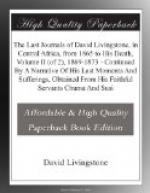In some cases, where the south-east rains are abundant, the Manyuema place the back side of the houses to this quarter, and prolong the low roof down, so that the rain does not reach the walls. These clay walls stand for ages, and men often return to the villages they left in infancy and build again the portions that many rains have washed away. The country generally is of clayey soil, and suitable for building. Each housewife has from twenty-five to thirty earthen pots slung to the ceiling by very neat cord-swinging tressels; and often as many neatly made baskets hung up in the same fashion, and much firewood.
5th November, 1869.—In going we crossed the River Luela, of twenty yards in width, five times, in a dense dripping forest. The men of one village always refused to accompany us to the next set of hamlets, “They were at war, and afraid of being killed and eaten.” They often came five or six miles through the forests that separate the districts, but when we drew near to the cleared spaces cultivated by their enemies they parted civilly, and invited us to come the same way back, and they would sell us all the food we required.
The Manyuema country is all surpassingly beautiful. Palms crown the highest heights of the mountains, and their gracefully bended fronds wave beautifully in the wind; and the forests, usually about five miles broad, between groups of villages, are indescribable. Climbers of cable size in great numbers are hung among the gigantic trees, many unknown wild fruits abound, some the size of a child’s head, and strange birds and monkeys are everywhere. The soil is excessively rich, and the people, although isolated by old feuds that are never settled, cultivate largely. They have selected a kind of maize that bends its fruit-stalk round into a hook, and hedges some eighteen feet high are made by inserting poles, which sprout like Robinson Crusoe’s hedge, and never decay. Lines of climbing plants are tied so as to go along from pole to pole, and the maize cobs are suspended to these by their own hooked fruit-stalk. As the corn cob is forming, the hook is turned round, so that the fruit-leaves of it hang down and form a thatch for the grain beneath, or inside it. This upright granary forms a solid-looking, wall round the villages, and the people are not stingy, but take down maize and hand it to the men freely.
The women are very naked. They bring loads of provisions to sell, through the rain, and are eager traders for beads. Plantains, cassava, and maize, are the chief food. The first rains had now begun, and the white ants took the hint to swarm and colonize.
6th, 7th, and 8th November, 1869.—We came to many large villages, and were variously treated; one headman presented me with a parrot, and on my declining it, gave it to one of my people; some ordered us off, but were coaxed to allow us to remain over night. They have no restraint; some came and pushed off the door of my hut with a stick while I was resting, as we should do with a wild-beast cage.




